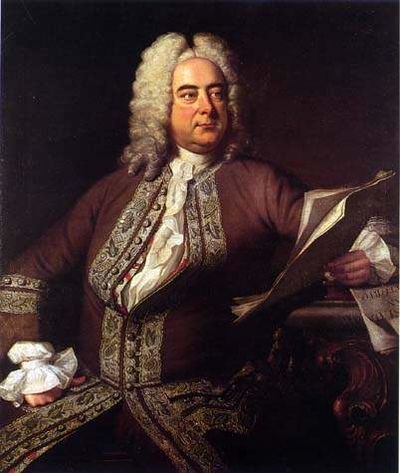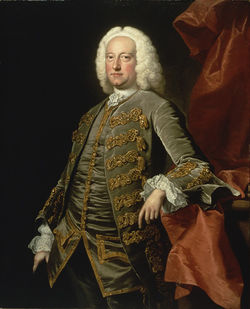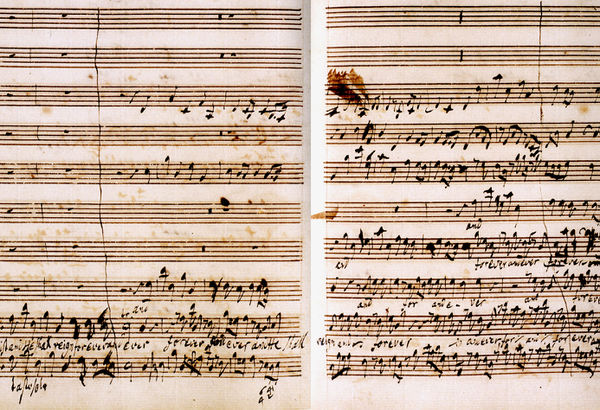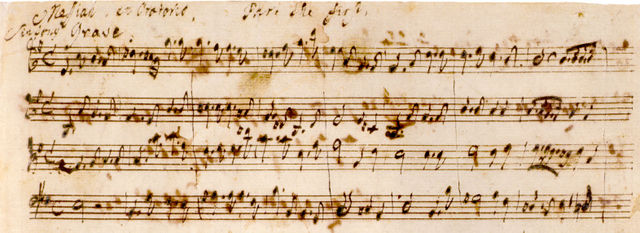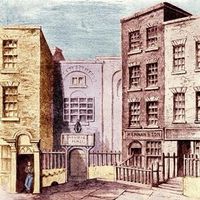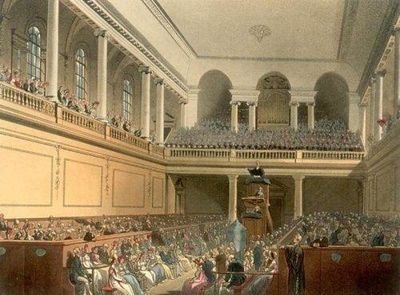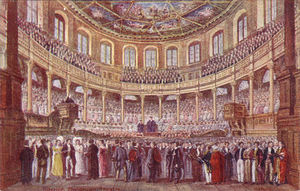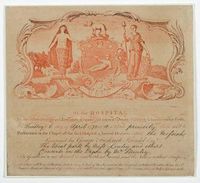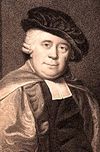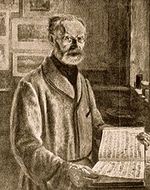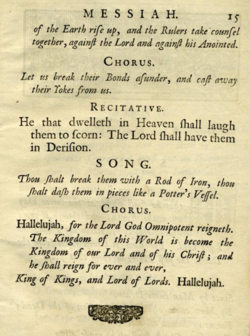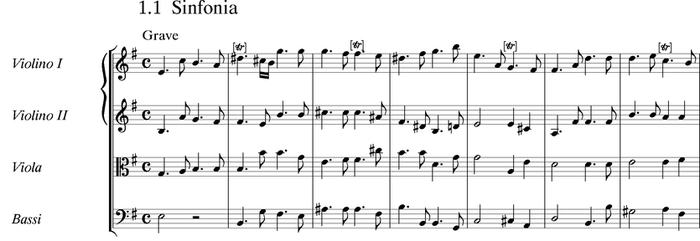Messiah
Messiah (HWV 56)
Composed by George Frideric Handel
Overview
Handel's famous oratorio Messiah comes down to us as the best known and most widely performed of his compositions. Its fame rests on many factors—its gestation under favorable social circumstances then, its versatility and easy availability in ours. Overriding these extraneous factors is the virtue of the music itself: majestic and contrite by turns, carefully balanced throughout, and within the capabilities of diligent amateurs. This website provides copious performing materials for Messiah, with substantial background information concerning the rubrics on which these materials are based.
Handel's Messiah
Composed in the summer of 1741 and first performed in the spring of 1742, Messiah is suspended between sacred and secular spheres. The title Messiah, used for its first performances in Dublin, suggests a sacred work, although it was initially performed as a concert piece. It was simply called a Sacred Oratorio in the libretto for its London premiere (1743), but objections were then raised to its performance in the theater. Not until performances began in the chapel of London's Foundling Hospital (1750) was the ambiguous nature of the work matched by a similar ambiguity of performing space. The thrust of classicism appropriated for the secular world much textual material from Biblical studies.[1]
All of Handel's oratorios reflected to one degree or another his cultural immersion in an Anglo-Protestant society. When Messiah was first performed Dublin had a substantial Anglo-Irish nobility and maintained strong cultural ties to London. Messiah can be differentiated from most earlier oratorios by Handel in the degree to which the ideas of Charles Jennens, Handel's collaborator, drove the work. It is Jennens's theological views that are projected. Messiah's chameleon ability to transcend social and cultural boundaries continues to expand up to the present day.
The Architecture of Messiah
The oratorio consists of three parts: (1) music narrating highpoints from the prophecy of Isaiah to the early life of Jesus; (2) Jesus's birth, death, and resurrection; and (3) the sins and judgment of mankind. Each of these can be parsed into several scenes. Handel's choruses serve as a good guide to the many segments of the work.
In Part One the choruses are these:
1.4 And the glory of the Lord
1.7 And He shall purify
1.10 O Thou that tellest
1.13 For unto us a child is born
1.19 Glory to God in the highest
1.23 His yoke is easy
All the choruses are present in the autograph manuscript of 1741. They proved to be the most unvarying components of the work. The choruses, which are scored for sopranos, altos, tenors, and basses, call for string accompaniment. Trumpets are required in "Glory to God in the highest," and oboes were added in later revisions.
The same principles pertain to the remaining choruses of the work (with one exception*): all of them originate in the 1741 autograph. Part Two has the largest number of choruses and culminates with the great "Halleluiah" chorus. Where they overlap with choruses, adjustments to solo parts caused some variability of scoring from version to version.
2.1 Behold the Lamb of God
2.3 Surely, surely; And with his stripes
2.4 All we like sheep
2.6 He trusted in God
2.11 Lift up your heads
2.13 Let all the angels of God worship Him
2.16* Their sound is gone out
2.18 Let us break their bonds
2.21 Halleluiah
The movement we term 2.16* in our edition exists in five versions and the the chorus indicated here first occurs as a separate one in 1745. The segmentation of the text and the portions assigned to soloist and chorus vary from case to case, both before and after 1745. (Details are given in the downloadable list of versions from Handel's lifetime.) Oboes are also called for in this later accretion. The "Halleluia" chorus includes parts for trumpets and timpani.
Part Three is much simpler in its structure. Its choruses are these:
3.2 Since by man came death (with soloists)
3.7 But thanks be to God
3.9 Worthy is the Lamb
3.10 Amen
Trumpets and timpani are required in the final chorus and concluding "Amen."
The "Halleluia" Chorus
Messiah is especially noted for its choruses. The most famous one is the "Halleluia" chorus that ends Part Two. The choruses are noted for their imitative vocal entries, which contribute to cascades of contrapuntal complexity as various groups of instruments highlight particular passages or counter vocal entries with musically independent passages.
Messiah during Handel's Lifetime
Handel thought when he composed the work that Messiah would be performed in London. A visit to Dublin that began in November 1741 was intended to enable the composer to offer a series of subscription concerts to Anglo-Irish patrons. Its great success led to a second series, which was launched on February 17, 1742. [2] The idea of performing Messiah in Dublin came about as a bonus offering.
An open rehearsal of the oratorio took place the day after the second series finished. It was immediately declared "the finest Composition of Musick that ever was heard." Although it is thought that this view was partly promotional, the evaluation was sustained by its official premiere the following Tuesday (April 13, at noon)
Background to Handel's Visit to Dublin
Messiah had come into being at the request of Dublin's Charitable Infirmary to compose a work to encourage contributions to the "Dublin sick." At the time hospitals were used more to separate the sick from the rest of society than to treat their maladies. When Messiah had its final Dublin performance, on June 3, there were some changes of cast, and organ concertos were performed with it. Other concerts filled the intervening weeks. Among them were a benefit for the Dublin music publishers William and Bartholomew Mainwaring, and Handel's oratorio Saul. Its Dead March became an instant favorite.
Reception and Performance History
Our knowledge of the performance history of Messiah between its composition in September 1741 and Handel’s death in April 1759 is rich and constantly changing. Messiah's most persistent detractor was Charles Jennens, its librettist. Handel’s original setting was weak and unsatisfactory, according to Jennens. He pressed the composer many times to remedy what Jennens perceived as its perceived defects. In January 1743 Jennens wrote to his friend Edward Holdsworth,
| Messiah has disappointed me, being set in great haste, tho’ [Handel] said he would be a year about it, and make it the best of all his Compositions. I shall put no more Sacred Words into his hands, to be thus abus’d. |
Six weeks later he wrote further on the subject,
| ‘Tis still in his power by retouching the weak parts to make it fit for publick performance; and I have said a great deal to him on the Subject; but he is so lazy and so obstinate, that I much doubt the Effect. |
Jennens allowed on March 24, 1743 (one day after the London premiere) that “in the main” Messiah was “a fine Composition,” but he continued to pressure Handel to make changes. And Handel did, so much so that the work was never entirely stable until the composer’s death. Some of the changes responded to Jennens’ wishes, but other simply accommodated changes in casting. In August 1745 Jennens reported to Holdsworth
| I have with great difficulty made him correct some of the grossest faults in the composition, but he retained his Overture obstinately in which there are some passages far unworthy of Handel, but much more unworthy of Messiah. |
The oratorio attracted a growing following in the cathedrals and choral societies of the Western counties and into Wales. In England the choruses of Messiah became especially celebrated. Under the direction of William Boyce, there was a performance in Hereford Cathedral in September 1750. A month later the work was given in Salisbury Cathedral. Performances in Bristol, Gloucester, and Leicestershire occurred between 1757 and 1759. Many performances of excerpts were given by the Hereford, Gloucester, and Worcester choral societies.
As the oratorio became more widely circulated, its component parts were subject to change, although the choruses were entirely stable. Although Handel continued to experiment with the work, some numbers that had been changed in the 1740s were restored to their original condition in the 1750s. Twelve distinct productions (most consisting of two or three performances) can be counted between 1743 and March 1759.
Dublin Performances
To its first audience in Dublin Messiah was a resounding success, for it achieved a great charitable goal: poor debtors were released from prison in proportion to its financial success. The composer and two singers of the original cohort donated their share of the proceeds to this cause. Nine performances in Dublin can be dated between the premiere on April 13, 1742, and an Advent performance on December 16, 1756. All of them seem to have met with the “universal applause” merited by the subject, the setting, and the qualities of the performances. All were benefits.
Although there was a performance on June 3, 1742, and February 1, 1744, it appears that from 1745 onward Messiah was an Advent work in Dublin. The actual number of special and seasonal performance there within Handel’s lifetime must easily have reached fifteen. Handel was present for the premiere, but in subsequent years others were in charge. G. B. Marella was the conductor in the 1750s. The performing tradition in Dublin is less well documented than in England. We can be sure, though, that Messiah was invariably well received there. Attendees traveled tens of miles to witness the performance, year in and year out.
London Performances: Covent Garden
Initially, Messiah’s main roost in London in the 1740s was the Theatre Royal in Covent Garden. In England the work was considered a Passion oratorio. [Its first performance was marked for neither Advent nor Passion, since it took place almost four weeks after Easter (which fell on March 25 in 1742).] The first performance in London took place on March 23, 1743. The initial reception was more mixed than in Dublin. The cause of charity was absent. Some influential attendees regarded passages of the text setting as insensitive to the meaning of the words.
Covent Garden was, of course, an opera house. Protestant England was more lax about opera performances during Lent than were Catholic countries, but oratorios offered a convenient compromise by way of the genre’s ambiguity. Musically, both consisted primarily of an opening sinfonia, arias, and recitatives. In Handel’s case, the differences between opera and oratorio were spelled out by their texts and the portions of it that were strongly emphasized musically. Handel also provided many choruses, which would have been fewer in opera. Jennens had had a strong desire to promote his singular idea of “kingship” in the musical realization of Messiah, and in this regard Handel did not fail him: the “king of kings” theme is put in high relief in the "Halleluia" Chorus, which has always been Messiah’s most highly prized element.
London Performances: The Foundling Hospital
London's Foundling Hospital, established on Bloomsbury Fields in 1739, mirrored in its aims the well established institutions for orphans in Italy and France. The most famous of these was the Ospedale della Pietà in Venice, where all the orphans were female and where a select group reached the stature of musical professionals under the tuition of such maestri as Antonio Vivaldi and Giovanni Porta.
Such institutions fostered strong musical allegiances because the noble families who supported them believed that music bettered the soul. They particularly cherished music made well by children. The Foundling Hospital's benefactors include such noted painters as Sir Joshua Reynolds, Thomas Gainsborough, and Handel himself. The composer provided an organ and gave benefit performances at the Hospital. At his death, a valuable set of performance parts fell became the possession of the institution. Today the park known as "Coram's Fields" marks the spot where the original Hospital stood.
Excerpts from Messiah were performed at the Foundling Hospital in May 1749, but the first full performance in its chapel took place a year later. Messiah's annual performance became the main fundraising vehicle for the institution, and the Foundling Hospital concerts were the most celebrated of all Messiah performances given during Handel’s lifetime. The nine documented complete concerts given up to 1759 all enjoyed his direct participation at the organ, for Handel continued to provide an organ concerto even after he was beset by blindness in 1752. The concerts were usually associated with the feast of Ascension (forty days after Easter). John Christopher Smith conducted from 1754 onward.
Oxford and Cambridge Performances
Messiah had a slightly different identity in Oxford, where it was performed in April 1749 at the Radcliffe Camera. It was also given complete performances in the Sheldonian Theatre (where Handel's Athalia had had its premiere in 1733) as part of the commemoration festivities of July 1754 and July 1759. Starting in 1755, various parts of Messiah were performed separately for subscription concerts in the Holywell Music Room. One memorial performance was given at Senate House, Cambridge, under John Randall (later a music publisher) in May 1759.
Performances after Handel's Death
Performances of Messiah remained popular in England throughout the eighteenth and nineteenth centuries. At Covent Garden Smith and John Stanley continued the oratorio series through the mid 1770s, when the concerts moved to Drury Lane Theater. In 1784 a commemorative performance of gigantic proportions was intended to mark the first anniversary of Handel's birth (erroneously believed to have taken place one year earlier than it had). [3] More than 500 performers were involved in the Westminster Abbey performance. (A second commemoration in London's Crystal Palace took place in 1884.)
Messiah in Monumental Editions
Because of the immediate popularity of individual choral and vocal numbers in Messiah, the work was rapidly circulated and adapted to varying circumstances. The rise of choral societies in the third quarter of the century had a symbiotic relationship with Handel's masterpiece. The more the work was performed, the greater the number of groups performing it. Inevitably, each new venue created its own opportunities and limitations. Soloists and sometimes keys of particular pieces could be altered. Orchestration accommodated the resources available. Performance practices evolved in more general ways.
The Arnold Edition of Handel's Works
Samuel Arnold was the first person to collect all of Handel’s then-known music and publish it. By the time he did, performance practice had evolved in general ways that he applied to his edition.
His edition of Messiah appeared in 1790. It contains much richer figuration of the basso continuo than earlier manuscript versions. This is likely to reflect the reduced training that accompanists were receiving in the “realization” of the sketch of accompaniment that a continuo part otherwise provided. A more detailed prescription was required. The skills that he brought to the task from long experience as a harpsichordist at Covent Garden suggest that his figuration represented the highest standards of the time.
In 1793 Arnold was appointed organist of Westminster Abbey, where he was buried in 1802. As a composer he is best remembered for his Psalms of David (1791), several oratorios, a few operas, and many hymns.
The Händel-Gesellschaft (HG) Edition
In 1858 work was began on the more extensively “complete” works that were produced by the Händel-Gesellschaft (Georg Friedrich Händels Werke) under the direction of Friedrich Chrysander. By its completion in 1902 it contained 94 volumes (several in two tomes) and five supplements. Chrysander also edited all the published works of Arcangelo Corelli (now available in PDFs with associated MIDI files at http://corelli.ccarh.org), Bach’s keyboard works, and Palestrina’s motets.
Chrysander's edition of Messiah appeared as Vol. 45 (1902). It can be downloaded from the website of the Munich Digitalization Center (part of the ViFaMusik project) at http://daten.digitale-sammlungen.de/~db/0001/bsb00016880/images/index.html.
The Hallische Händel Ausgabe (HHA)
The current effort to publish all known music by Handel resides with the edition managed in Halle, Germany. It was initiated in 1952 with the intention of supplementing HG, but discoveries continue to be made, and in 1958 it was launched as a new edition. Although it was through most of its publication history signaled by the letters HHA, these have now been superseded by the use of Baselt's Handel catalogue of works (HWV for the Händel-Werke-Verzeichnis).
The MuseData Edition of Messiah
Multitudes of stand-alone editions of Messiah exist. The MuseData edition, undertaken by the Center for Computer Assisted Research in the Humanities in cooperation with Philharmonia Baroque in 1989, was intended to produce a collection of performing materials that represented all versions of the work known through the time Handel died in 1759.
Identifiable Versions (1741-1761)
Eighteen manuscript sources are regarded as pertinent to early performances, but surviving source material and documented performances do not match on a 1:1 basis. Numerous eye-witness accounts of individual performances suggest that we will never know every detail of any one of them. Some known performances are survived by no sources. Multiple performances with differences between them may need to be traced through the complex fabric of a single, many-times-altered source. Otherwise valuable early materials postdate Handel’s death and may reflect the opinions and preferences of the transcriber. A best-guess effort to define Handel's last thoughts on preferred versions of individual pieces within the work was hypothesized by Jens Peter Larsen.
Over time the differences from one version to another can be said most often to reflect changes in voicing or orchestration. A few pieces became shorter with revision. There was a slight increase in the use of choral material, although the choruses were by far the most stable elements of the work. There is no formula by which these tendencies can be broadly applied. Messiah's continuous state of evolution leaves many open questions for today's performers. In the case of Messiah, the number of sources surviving from Handel's own time is fewer than the number of documented productions.
To relate fluctuating source contents to MuseData performing materials please consult Table A (downloadable below). Version Nos. 1,2: Discrepancies are first noted between Handel's autograph (summer 1741) and the libretto for the first public performance (April 1742). Version Nos. 3-6: Librettos map changes from year to year, but the music for all the Covent Garden performances issues largely from one manuscript source. Version No. 7: We know that from 1754 onward Handel participated in performances at the Foundling Hospital. The Hospital's performing parts survive from these years. Version No. 8: Handel's conducting score is a valuable source for mapping changes in his thinking and documenting his own idea of a best version. Version No. 9: The 1761 manuscript by James Matthews is regarded as contemporary with Handel's own versions because Matthews sang in multiple productions of the work.
1 Handel's autograph manuscript (1741)
2 Libretto for first public version (Dublin 1742)
3 Covent Garden libretto for first English version (1743)
4 Covent Garden libretto (1745)
5 Covent Garden libretto (1749)
6 Covent Garden libretto (1750)
7 Foundling Hospital performances (1754-59), parts (1759)
8 Handel's conducting score (c. 1758)
9 Manuscript of James Matthews (chorister) (1761)
Table A. Versions of Messiah reconciled to MuseData Editions.
The MuseData editions (1990, 2003) attempt to incorporate as many of the variants as needed to perform one or another historical version with reasonable fidelity to what we know of its probable contents. These variants are explained in Table A. Note that certainty is not always possible, and that in a few cases the content may be certain but the music is lost.
Table B. Roadmap to MuseData editions of Messiah.
Principal Manuscript Sources
The sources consulted are shown in Table 1. The sigla (abbreviations indicating country, city, and library; shown in parentheses) follow the usage of RISM. (See http://rism.ub.uni-frankfurt.de/bibliothekssigel/BIBVERZ_06-06-16.pdf.)
| Place: Library | Shelfmark | Date(s) | Copyist(s); Notes |
|---|---|---|---|
| 1: London: British Library (GB-Lbl) | R.M.20.f.2 | 1741 | Autograph Score by G. F. Handel |
| 2: Oxford: Bodleian Library (GB-Ob) | Tenbury MSS 346-7 | 1742, 1743, 1745, 1750 | Single score, multiple versions |
| 3: London: Foundling Hospital (GB-Lfm) | Gerald Coke Collection | 1759 | Parts |
| 4: Hamburg: University Library (D-Hu) | MA/1030 | 1758-1760 | Conducting score |
| 5: Dublin: March Library (IRL-Dm) | Z.i.2.26 | 1761 | MS of James Matthews (chorister) |
The Dublin libretto (1742) shows minor changes in the first version as it was performed in 1742. The variant of “How beautiful are the feet” that we identity as 2.16E (closely related to 2.16D) may represent a modification prepared for the Chapel Royal in coincidence with the earliest London performances or perhaps the Dublin premier.
Listening Materials
The earliest collective use of the the variant material included in the MuseData score and parts was by Philharmonia Baroque Orchestra (directed by Nicholas McGegan) with the UC Berkeley Chamber Chorus (led by Bruce Lamott). Harmonia Mundi recorded a "main version" and most variants in 1991 (HMU 907050.52). The CD-user could, by following a trail through the bands of the CD set, program any of the versions that have survived from Handel’s lifetime (or shortly thereafter). More recently, these materials have been made available online through multiple vendors, e.g. amazon.com (http://www.amazon.com/Handel-Messiah/dp/B000QQUX1Y) and iTunes (http://itunes.apple.com/us/album/handel-messiah/id82182810). Many other recordings of the work exist, but these are only cases we know of that make alternative versions available for comparison.
Performance Issues
Consultation of sources never resolves all performance questions. Like Handel’s oeuvre in general, Messiah raises a host of uncertainties about exactly what the composer might have intended. Some issues are recurrent throughout Handel’s works:
1 Doubling of voices and instruments: Handel’s particular style of composing music offers economies of paper usage wherever possible. This sometimes makes his intentions unclear. Violins were usually separated into primi and secondi (firsts and seconds). Only documentary evidence gives any indication of how many instruments played to a part.
2 Bassi and Tutti bassi: In a context of strings only, Handel’s bassi were cellos and double basses. In a string-and-wind context, bassi parts could include bassoons: the cues “with bassoon” and “without bassoon” (con or senza fagotto) are the only clues to shifts in the accompanying instruments. The cue Tutti bassi has the overall intent of requiring all available instruments of the bass register, but its instructional value is relative, not absolute.
3 Oboe scoring: Oboe parts and cues are absent in the autograph and other manuscripts of the 1740s, but their use is well documented for the Foundling Hospital performance of the 1750s and may have been used prior to written indications. Parts for oboes are preserved in the Coke Collection (at the Foundling House) and in a manuscript at King’s College, Cambridge, dating from the last quarter of the eighteenth century.
4 Brass and Percussion: Clear evidence of the use of trumpets with timpani becomes firmer in the 1750s.
Overall usage clearly varied from place to place. Oboes, horns, and kettledrums (timpani) were all used at the Foundling Hospital performance of the 1750s. Two oboes and one bassoon, with horns, trumpets, and drums in unspecified numbers, played with a string orchestra of 24 at Salisbury Cathedral in 1752. A Foundling Hospital performance in 1754 involved four oboes, four bassoons, two trumpets, two horns, a pair of kettledrums, and a string section of 24. It is consistent with these reports that the Foundling Hospital and Matthews manuscripts provide the clearest indications of what the oboes played.
Some individual arias assumed particular identities as they were transmitted from place to place. They often acquired heavy ornamentation in the process. Among the most informative early manuscripts are the Goldschmidt manuscript in the Pierpont Morgan Library, New York, and the Matthews manuscript in the Marsh Library, Dublin.
Some choices are left to the discretion of performers. For example, soprano and tenor are alternatives for a few numbers, but if no change of key, text, or instrumentation is involved and only octave transposition is required we provide only one text.
Variations in content are largely confined to a few numbers in each section of the oratorio. Some were changed over and over. Full details correlating MuseData content with specific versions can be downloaded in Table A.
Score and Parts
We provide two largely overlapping editions of Messiah. The first (1990) attempted to combine all the materials required to recreate a number of the earliest performances. It was largely based on the Chrysander version, with revisions reflecting more recent discoveries by Nicholas McGegan, John Roberts, and Eleanor Selfridge-Field. A few practical changes were suggested by performers. Although a total of eleven versions are partly or wholly discoverable, they are subsumed in a collection of five paths (A, B, C, D, E). (Most numbers remain the same from one version to the next.) The 2003 materials take advantage of improvements in typography and enhanced continuo figuration (based on the Arnold edition).
- Full Score (2003 version), 280 pages.
- Parts: Violin 1, Violin 2, Violin 3, Viola, Basso continuo, Oboes 1 & 2, Trumpet 1, Trumpet 2, Timpani.
- Continuo part (2003 version), with figured harmony based on the Samuel Arnold Edition of 1790, 101 pages.
- Expanded Continuo part (2003 version), with figured harmony based on the Samuel Arnold Edition of 1790, 197 pages. Included continuo part plus treble staff with melodies and primary voices.
- Choral score (1990 version). Movements with vocal parts, plus first violin and basso continuo parts.
- Full Score (1990 version), 404 pages.
Footnotes
- ↑ Peter Gay's phrase "pagan Christianity" (1966: Vol. 1[1]) is a simplified term for a widespread phenomenon.
- ↑ Starting with a performance of Alexander's Feast, the new series continued on Wednesdays through April 7, when the featured work was a revised version of Esther.
- ↑ The error was based on a failure to reconcile Julian dates falling between January 1 and March 25 with with the Gregorian calendar, which was adopted in England 1752.[2] Handel was born on February 23, 1685, and arrived in England in 1711.
Bibliography and Weblinks
Baselt, Bernd. Dokumente zu Leben und Schaffen, v. 4 of the Händel-Handbuch Kassel: Bärenreiter, 1985.
Beeks, Graydon. "Messiah Anniversary," Newsletter of the American Handel Society, (August 1991), pp. 1-5. Reproduced at http://www.americanhandelsociety.org/documents/Summer1991.pdf.
British Library: Autograph Manuscript [R.M.20.f.2] of Handel’s Messiah (as a “virtual book”): http://www.bl.uk/onlinegallery/virtualbooks/detect.html?id=38FD72B2-5B98-4FC2-AAAE-98E717E8D512&accessfolder=handel
Burrows, Donald. “'Mr. Harris's score': A new look at the 'Mathews' manuscript of Handel's Messiah,” Music & Letters (2005), 86(4) 560-572.
Burrows, Donald. “The autographs and early copies of Messiah: Some further thoughts, Music & Letters (1985), 66(3) 201-19.
Larsen, Jens Peter. Handel’s Messiah. New York, 1972.
McGegan, Nicholas. "Which Messiah?," Musical Times, 133(1797) 577-579.
Marx, Hans Joachim. “Die 'Hamburger' Direktionspartitur von Händels Messiah,“ [“The Hamburg Conducting Score of Handel’s Messiah“], Festschrift Klaus Hortschansky zum 60. Geburtstag [Festschrift for Klaus Hortschansky on his 60th birthday]. Tutzing: Hans Schneider, 1995, pp. 131-138. ISBN: 3-7952-0822-X.
Shaw, Watkins. A textual and historical companion to Handel's Messiah, Sevenoaks (UK), 1965. Rev. edn., 1982.
Shaw, Watkins. “Handel's Messiah: Supplementary notes on sources,” Music & Letters (August 1995), 76(3) 356-368.
The complete Händel-Gesellschaft edition is available in digital files from the Munich Digitalization Center’s website: http://daten.digitale-sammlungen.de/~db/ausgaben/uni_ausgabe.html?projekt=1193214396&recherche=ja&ordnung=sig
Credits
Over the course of 22 years, the MuseData Messiah project has benefitted from the contributions of many people. The original edition was by Nicholas McGegan, John Roberts, and Eleanor Selfridge-Field, with encoding by Frances Bennion and Edmund Correia Jr. The introduction of the Arnold continuo figuration and preparation of the short scores (2003) are the contributions of Walter B. Hewlett, who also developed the software used for preparation and management of the score and parts. This wiki site has been developed by Craig Stuart Sapp and Eleanor Selfridge-Field. Valuable insights and advice have been given in recent years by Don Anthony, Graydon Beeks, Ilias Chrissochoidis, John Phillips, and several others.
Published on December 21, 2011 by the Center for Computer Assisted Research in the Humanities[3] at Stanford University. Comments may be sent to esfield ++at++ stanford.edu
